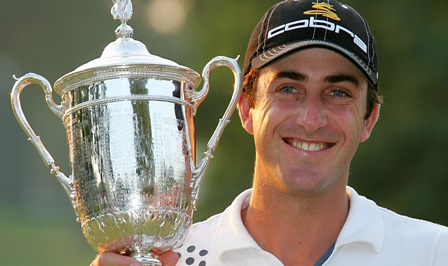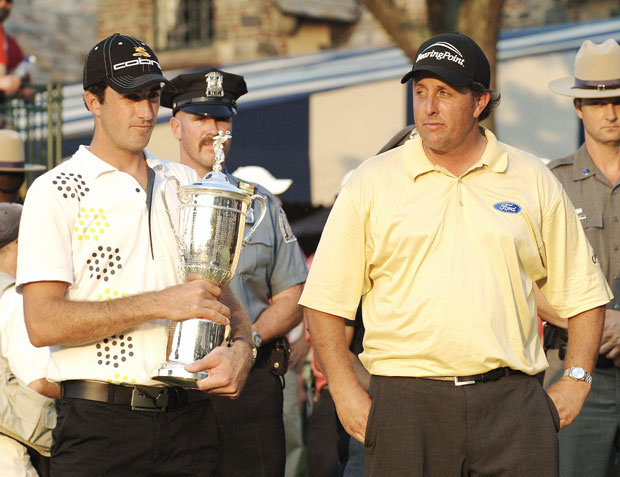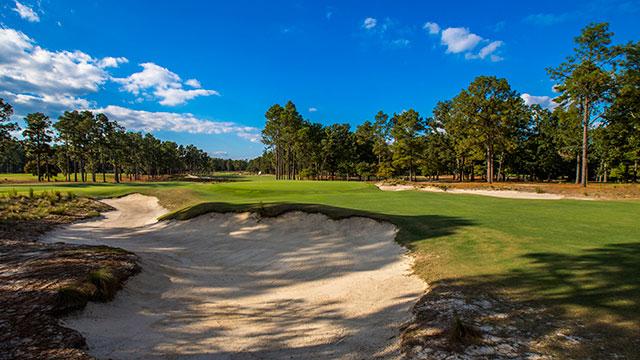It’s been seven years since Geoff Ogilvy became only the ninth Australian to win a Major Championship in capturing the 2006 U.S. Open at Winged Foot.
Ogilvy’s one shot success was also the 15th Major won by an Australian and the Adelaide-born golfer becoming only the second to lift the gleaming U.S. Open trophy.
And with the U.S. Open now just a matter of weeks away Ogilvy is already looking ahead to June 12th, and the day after he turns 37 years of age, to teeing-up at Pinehurst No. 2 where he had played all four rounds of a U.S. Open for a first time in 2005.
“Pinehurst is way up there among my favourites as Pinehurst is one of the few places in the world that just feels like a place where they just play golf,” he said.
“The whole town, the hotels, all the golf courses and everything about it has a cool feeling about it, so it’s right up there.”
This year’s U.S. Open competitors will arrive at Pinehurst No. 2 and a golf course so unlike the quintessential U.S. Open course where more often than not it will be trying to thread your drive through the eye of a needle to find a small corridor of fairway.
Instead Pinehurst No. 2 has been transformed dramatically since 2005 when New Zealand’s Michael Campbell kept Tiger Woods at arm’s reach to become only the second Kiwi golfer to win a Major.
“Golf is definitely more interesting when the recovery shot is a big part of the game,” said Ogilvy.
“Typically, the USGA take the normal recovery shots out of play because of the long grass that prevails at a U.S. Open venue.
“However Pinehurst has always been about positions and angles, and you are always going to have situations where you are better off in a bad lie in the right angle than a good lie in the wrong angle which is what golf at its best is, like Augusta National.
“Pinehurst should be similar. I’ve seen the pictures of the changes and it looks amazing. It looks like it is suppose to but then there will be guys who will not like the hit-and-miss aspect of what they’ve done.
“But if Pinehurst No. 2 is set up similar to what I’ve seen in the photographs then you’re going to get a ‘Hall of Fame’ winner, as it always throws up great champions.
“And I also believe golf is much more interesting when we are making the decisions in how we play the game, and that’s why the Masters is so interesting to watch as it’s doing guys heads in all time. Pinehurst should provide a similar sort of mental test and the biggest tournaments should.
“So it will be interesting seeing the decisions the guys will make because they could be poor ones but sometimes great ones, and it’s definitely better playing that way than being dictated to by those who set up the course.”
And while Olgilvy will always be linked to Winged Foot, and while he’s itching to get to Pinehurst No. 2, he singled out Torrey Pines, and host of the 2008 U.S. Open, as the best set-up U.S. Open venue he’s played.
“Strangely, Torrey Pines in 2008 was just brilliant as they had that second or third year of that graduated rough, and that Kikuyu rough where the ball didn’t sink, and while it wasn’t great to be in it, it wasn’t a hack out,” he said.
“So the first 10 yards of the rough wasn’t a hack out as we’ve been so used to. So knowing what I knew about Torrey Pines it was a pleasant surprise when we got out onto the course, and I just loved that week and I thought it was great, and it helps also when it’s 72 degrees each day as they had complete control how the course was going to be as there was no rain all week.”
And having dabbled in some golf course redesign work in recent years, including overseeing changes to the famed Bonnie Doon layout in Sydney, Australia, Ogilvy admits he walks Major Championship venues with an even closer eye on the design of the course he’s playing.
“I’ve always have seemed to go to any golf course wearing also a type of golf design cap, even before I knew I was looking at a course like that if you know what I mean,” he said.
“But then in saying that I would be more excited going to Pinehurst than going to Torrey Pines.
“There is not really a lot to learn at Torrey Pines but in going to Pinehurst, you’re going to a golf course designed by Donald Ross. It was his pride and joy course and there is a lot of history as every great player in this game has played there.
“So it’s a pretty historic place and under appreciated in my view, so the old historic venues that have staged big tournaments like Winged Foot, Oakmont and Pinehurst excite me.”
What awaits U.S. Open competitors:-
- The course will be stretched out to 7,562 yards (par 70).
- The scorecard will include four par 4s longer than 500 yards, highlighted by the 528-yard 16th hole.
- The longest par 5 will be No. 10 at 617 yards.
- Three of four par-3s will be more than 200 yards in length: No. 6 (219 yards), No. 15 (202 yards) and No. 17 (205 yards).
- The course will play nearly 350 yards longer than it did in 2005, when Michael Campbell conquered the field over a 7,214-yard, par-70 layout.
- When Payne Stewart won in 1999, the course measured 7,175 yards.
- It will mark the third-longest layout in the history of the U.S. Open, behind only Congressional in 2011 (7,574 yards) and Torrey Pines (South Course) in 2008 (7,643 yards), both of which were par 71s.






